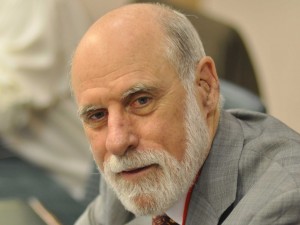

Father of the Internet Foresees Dark Digital Age, Suggests You Print Your Photos
Photo Print Pictures September 25, 2015 Editorial Staff 0

Vint Cerf, vice president and Chief Internet Evangelist for Google, warns of an impending and unpreventable “digital dark age” according to BBC. All data will be lost as future generations find itself increasingly incapable of accessing the records from the 21st century because of technological incompatibility issues (you may want to print at Walmart)
Widely known as a “Father of the Internet,” Cerf is the co-designer with Robert Kahn of TCP/IP protocols and basic  architecture of the Internet. For their achievement, they were conferred with the “U.S. National Medal of Technology” award in 1997 and with the “Presidential Medal of Freedom” in 2005.
architecture of the Internet. For their achievement, they were conferred with the “U.S. National Medal of Technology” award in 1997 and with the “Presidential Medal of Freedom” in 2005.
Cerf made his dire predictions regarding the approaching “digital dark age” during the annual meeting of the American Association for the Advancement of Science (AAAS) in San Jose, California.
To prepare for the coming of the “digital dark age,” he said he is calling for a “digital vellum,” the preservation of content that requires software context for interpretation much like the OLIVE (Open Library of Images for Virtualised Execution) project led by Mahadev Satyanarayanan at Carnegie Mellon University and IBM Research.
Vellum is resilient parchment made from calf skin that was used in the past to store knowledge meant to be passed to succeeding generations. In reference to his “digital vellum,” Cerf said: “If we want people in the future to be able to recreate what we are doing now, we are going to have to build the concept of preservation into the internet.
If we don’t do something about preserving the meaning of the ‘bits’, we may become something of a dark century. The problem is how to correctly interpret the ‘bits.’ What I want to emphasis is [we will need] software that knows what the bits mean.”
Cerf continued: “We think about digitizing things because we think we will preserve them, but what we don’t understand is that unless we take other steps, those digital versions may not be any better, and may even be worse than the artifacts that we digitized.”
One solution he recommends “is to take an X-ray snapshot of the content and the application and the operating system together, with a description of the machine that it runs on, and preserve that for long periods of time.” A corollary step would be to also preserve them in hard copy printouts.
During his AAAS symposium presentation, Cerf aired the following technical concerns regarding how his “digital vellum” proposal may be fleshed out: the preservation of physical bits and meta-data; the preservation of the application and OS software; the preservation of machine functionality descriptions; special copyright provisions for preservation practices; the development of formal descriptions for data structures, and attendant semantics; digital repositories, digital object identifiers, digital object architecture; and “pulling on the thread” to reconstruct renderings and interpretations.
For those who have personally experienced losing those precious files they stored in floppy disks or VHR tapes, they only too well what the Internet pioneer was speaking of. Better drop by your favorite Walmart outlet and have your most treasured photos printed now before you loss them too to the approaching “digital dark age.”

No comments so far.
Be first to leave comment below.